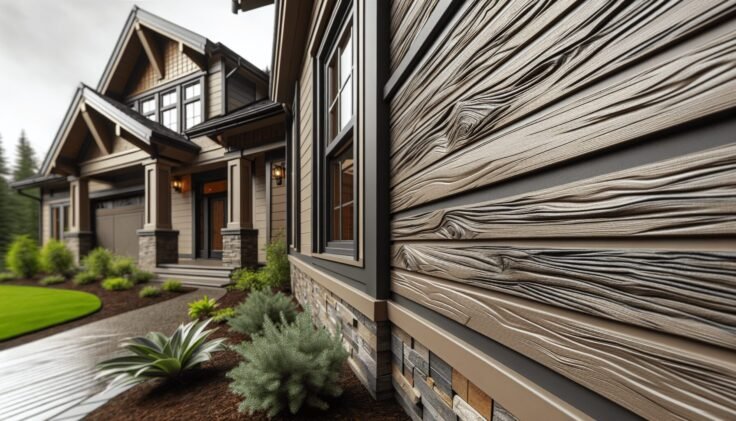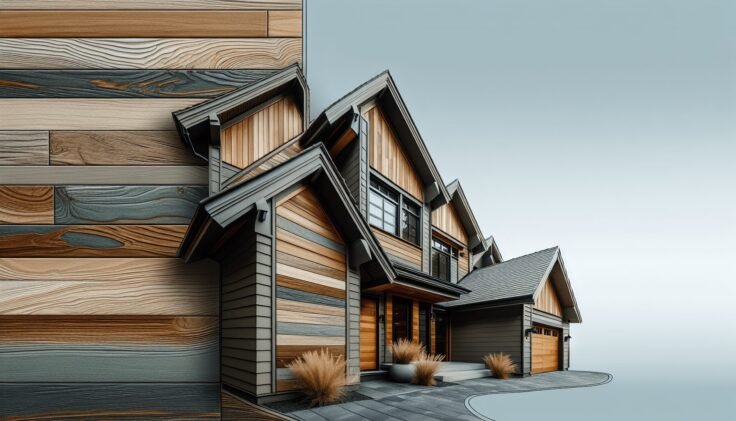Enhance Your Home’s Exterior with Driftwood Vinyl Siding
Have you ever thought about how much the exterior of your home affects its overall appeal? The siding you choose can transform an ordinary house into an extraordinary one. Driftwood vinyl siding is an excellent option to consider if you’re aiming for a combination of durability, aesthetic appeal, and low maintenance.

What is Driftwood Vinyl Siding?
Driftwood vinyl siding is a type of vinyl siding that mimics the appearance and texture of weathered wood. This type of siding captures the timeless beauty of driftwood, offering a rustic, natural feel without the upkeep wood requires. It’s made from high-quality vinyl materials designed to withstand various weather conditions and provide long-lasting beauty.
Benefits of Driftwood Vinyl Siding
Opting for driftwood vinyl siding comes with a range of benefits that can make a noticeable difference in your home’s exterior.
Durability
Vinyl is a robust material capable of withstanding harsh weather conditions, from intense sun to heavy rain. Driftwood vinyl siding is resistant to rot, insects, and other common issues associated with traditional wood.
Low Maintenance
One of the standout features of vinyl siding is its low maintenance. Unlike wood, which requires regular painting and sealing, driftwood vinyl siding retains its color and appearance with minimal effort. A simple annual cleaning can keep your home looking fresh and new.
Aesthetic Appeal
The textured look of driftwood vinyl siding brings an element of rustic charm. It can elevate the exterior of your home, making it stand out in your neighborhood. The natural gray hues blend well with various architectural styles and color schemes.
Cost-Effective
Vinyl siding is generally more affordable than wood, both in terms of initial purchase and long-term maintenance. You’ll save money on repairs and upkeep over the years.
Energy Efficiency
Modern vinyl siding options often come with an insulating layer, which can help improve your home’s energy efficiency. This can lead to savings on your heating and cooling bills.
Choosing the Right Driftwood Vinyl Siding for Your Home
Selecting the perfect driftwood vinyl siding for your home involves considering several factors to ensure you get the best fit.
Color Options
While driftwood is traditionally a grayish hue, vinyl siding manufacturers offer a variety of shades to match your personal style and preferences. Consider the overall color scheme of your home and surrounding properties.
Texture and Design
Vinyl siding comes in various textures, from smooth to rough finishes. Driftwood vinyl siding often has a textured surface to mimic natural driftwood. Look at samples to see which texture aligns with the aesthetic you envision.
Thickness
Siding thickness can affect durability and insulation capabilities. Thicker vinyl siding typically offers better performance in terms of durability and energy efficiency. It may come at a higher cost but can be worth the investment.
Brand Reputation
Research different brands and read reviews to gauge the quality and reliability of the vinyl siding you’re considering. Reputable brands often offer warranties and better customer support.
Installation
Proper installation is crucial for the longevity and performance of your siding. You can choose to hire professionals or go the DIY route if you have the necessary skills. Make sure to follow the manufacturer’s guidelines closely to avoid issues down the line.
Installation Process of Driftwood Vinyl Siding
Whether you’re a DIY enthusiast or prefer hiring a professional, understanding the installation process can help you make informed decisions.
Preparation
Before installation, ensure the surface is clean, dry, and free of any damage. Repair any structural issues and remove old siding if necessary.
Tools Needed
You’ll need a few basic tools, such as a utility knife, measuring tape, hammer, nails, chalk line, and a circular saw. Having the right tools will make the job easier and more efficient.
Measuring and Cutting
Measure your walls accurately to determine how much siding you need. Cut the siding panels to fit, allowing for proper overlap and expansion gaps. Vinyl siding expands and contracts with temperature changes, so it’s crucial to leave space for this.
Starter Strips and Corner Posts
Start by installing the starter strips at the bottom of the walls and the corner posts at all vertical corners. These elements are essential for a secure and professional-looking installation.
Installing Panels
Begin at the bottom and work your way up, locking the panels into place and securing them with nails. Make sure not to drive the nails too tightly, as this can prevent the siding from expanding and contracting properly.
Finishing Touches
Complete the installation by adding trim pieces, such as j-channel and soffits, to give your home a polished look. Double-check that all panels are secure and properly aligned.

Maintenance Tips for Driftwood Vinyl Siding
While driftwood vinyl siding requires minimal maintenance, a few regular upkeep tasks can help keep it looking its best.
Clean Annually
Use a garden hose or a pressure washer on a low setting to remove dirt and grime. A mild detergent can be used for tougher stains. Avoid using harsh chemicals or abrasive cleaners, as they can damage the vinyl.
Inspect Regularly
Take the time to inspect your siding periodically for any signs of damage, such as cracks or loose panels. Addressing issues early can prevent more significant problems in the future.
Prevent Mold and Mildew
Ensure good ventilation around your home and keep gutters clean to prevent water buildup, which can lead to mold and mildew. If you spot any mold, clean it promptly with a solution of water and white vinegar.
Touch Up as Needed
If your siding does get damaged, repair it promptly. Most minor issues can be fixed with a patch or replacement panel. Keeping some extra siding on hand can make these repairs more straightforward.
Environmental Impact and Sustainability
Choosing siding for your home isn’t just about aesthetics and durability; it also involves considering the environmental impact.
Eco-Friendly Manufacturing
Many manufacturers are committed to producing vinyl siding in environmentally responsible ways. Look for brands that use recyclable materials and sustainable production processes.
Energy Efficiency
Vinyl siding with insulation can help reduce your home’s energy consumption, lowering your carbon footprint. Improved insulation means less energy used for heating and cooling.
Recyclability
Vinyl siding is recyclable, and many recycling programs accept it. If you ever decide to replace your siding, you can contribute to reducing waste by ensuring it’s recycled properly.
Long Lifespan
The long lifespan of driftwood vinyl siding means less frequent replacements, reducing the amount of waste generated over time. It’s a durable choice that supports long-term sustainability.
Comparing Driftwood Vinyl Siding with Other Siding Options
It’s useful to compare driftwood vinyl siding to other popular siding options to make an informed decision.
| Feature | Driftwood Vinyl Siding | Traditional Wood Siding | Fiber Cement Siding | Aluminum Siding |
|---|---|---|---|---|
| Durability | High | Moderate | High | Moderate |
| Maintenance | Low | High | Moderate | Low |
| Cost | Moderate | High | Moderate | Low |
| Aesthetic Appeal | High | High | High | Moderate |
| InstallationEase | Moderate | Low | Low | Moderate |
| Energy Efficiency | High (with insulation) | Low | High | Moderate |
| Environmental Impact | Moderate | High | Moderate | Low |
Driftwood Vinyl Siding Design Ideas
Incorporating driftwood vinyl siding into your home’s exterior can be both exciting and transformational. Here are some design ideas to inspire you.
Rustic Charm
Pair driftwood vinyl siding with natural stone or brick accents to create a rustic charm. This combination works well for countryside homes or those wanting a vacation-cabin feel.
Modern Elegance
Use driftwood vinyl siding alongside sleek materials like metal or glass to achieve a modern look. This can give your home a unique, contemporary appearance that’s both stylish and inviting.
Coastal Vibes
Driftwood naturally evokes a coastal feel. Complement it with blue or white trim and nautical decor to create a beach-inspired aesthetic, perfect for homes near the water.
Classic Combo
Combine driftwood vinyl siding with traditional materials like cedar shingles or clapboard for a timeless, classic look. This mix can offer a balanced blend of old and new.
Frequently Asked Questions About Driftwood Vinyl Siding
Here are some common questions you might have about driftwood vinyl siding, answered for your convenience.
Is vinyl siding waterproof?
Yes, vinyl siding is designed to be water-resistant, preventing water from penetrating your home’s exterior walls.
Can vinyl siding fade?
While vinyl siding is designed to retain its color for many years, it can fade over time, especially in areas with intense sunlight. However, high-quality siding comes with UV protection to minimize fading.
Is vinyl siding fire-resistant?
Vinyl siding has some fire-resistant properties but can melt if exposed to intense heat. Always check the fire rating of the specific product you’re considering.
How long does vinyl siding last?
With proper care and maintenance, vinyl siding can last anywhere from 20 to 40 years, depending on environmental conditions and the quality of the product.
Can I paint vinyl siding?
Yes, you can paint vinyl siding, but it’s generally not necessary. If you choose to paint it, use a high-quality acrylic paint specifically made for vinyl surfaces.
Conclusion
Enhancing your home’s exterior with driftwood vinyl siding is a decision that offers numerous benefits, from aesthetic appeal to durability and low maintenance. It’s a versatile option that fits various architectural styles and budget preferences while also contributing positively to your home’s energy efficiency and sustainability. By meticulously considering aspects like color, texture, and installation methods, you can ensure that you choose the best vinyl siding to elevate the look and feel of your home. So why not give your home the beautiful, sustainable upgrade it deserves?